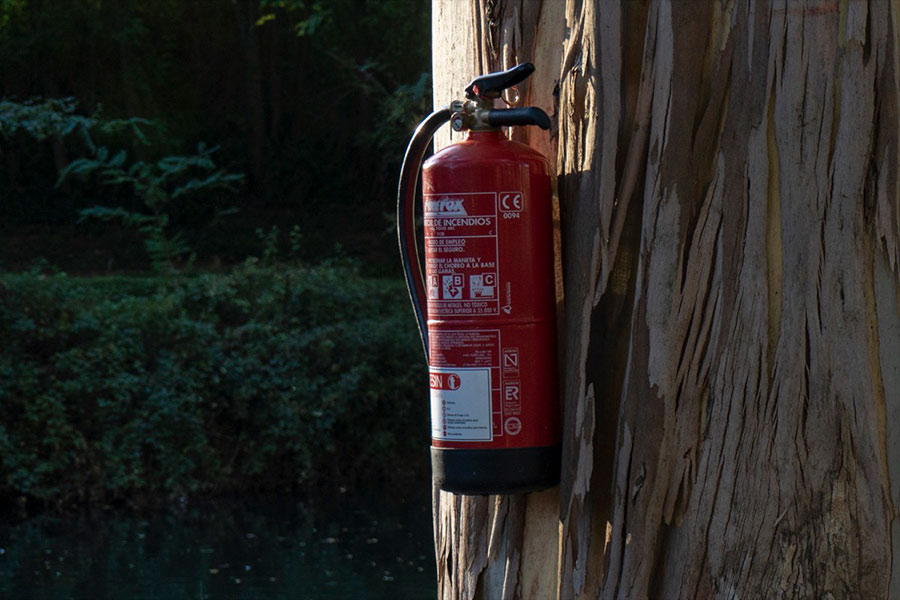A stunning outdoor public art installation today from Isaac Cordal that borders conceptual art, land art, and activist art. It depends on how deep into these woods you go.

We surmise that you are a true fan of art in the streets. If so, you’ll also fondly recognize the image of the fire extinguisher as the most badass uncontrollable way to spray your tag across a prominent city wall– the equivalent of a scream and a hot emotional mess all on display. Here Mr. Cordal hopes the symbolic image packs the same emotional/intellectual punch.
Mounted in his hometown, Pontevedra, in Galicia, which lies on the northern coast of Spain, the artist tells us that many areas of the earth are turning to monocultures, making us all much more fragile and susceptible to disaster. With greater diversity of plant life and the associated ecosystem, one species may suffer while the others can bridge the gap. The ironic term for this forest monoculture that Cordal addresses is called a “green desert.”

And that is what is happening in Pontevedra, “which has had a factory called Ence in operation since 1957, dedicated to making cellulose pulp from eucalyptus trees,” he tells us. “This invasive species has practically wiped out the native forests. Since then, a large part of northern Spain and Portugal has become a monoculture of this pyrophyte species, which alarmingly aggravates forest fires and destroys biodiversity, as well as drying up aquifers. The landscape has become a green desert, where nothing grows; it looks like a synthetic forest.”
“We must recover our lost paradise that still remains resilient.”

Walking through these woods, you may generally find the blue, green, and brown hues soothing and welcoming – the canopy overhead shielding you from the sun, and the crunch of the leaves and branches beneath you is enlivening. This fresh interplay makes one feel adventurous, on the lamb with a sense of possibility. When you see Cordal’s fire extinguishers hung with an alarming sameness, you may also question the uniformity of tree species. Something is precisely amiss.
Without becoming too complicated, the strength we are losing is in the variety – and Cordal says the current solutions offered are too superficial and insincere.

“The project arises from the lack of a forestry policy in accordance with the current situation,” he says. This idea inspired his installation to instantly help people connect the idea. “The idea of decorative or marketing solutions is so fashionable today in the era of greenwashing. Our actions remain a kind of make-up to make us feel less guilty about the future.”
Cordal explains that the term ‘green desert’ arose in the 1980s when Brazil’s cellulose industry left the people with vast tracks of the same trees. He says this approach only fuels a hellish future, and we’re not doing much to alleviate the situation.
“Current forestry policy is more decorative than effective,” Cordal says. “We need a forestry policy that controls the monoculture of eucalyptus in Galicia, and northern Spain, that protects native biodiversity, that puts an end to this green, lifeless desert that has colonized our territory.”


Other Articles You May Like from BSA:
This Sunday's Images Of The Week seems to have an overriding theme which wasn't really planned. It just happened. A preponderance of stencils, many of them miniature and most placed without permi...
Today some progress shots - these projects were not completed while we were shooting so you’ll want to go to the Museum Mile today along Bülowstraße (Berlin U-Bahn). The Urban Nation Art Mile (Artme...
The storied, busy, festive Spanish city of Valencia lies about an hour south of Fanzara, and the difference between the two could not be more pronounced. One of many across the country, this small to...
Boom! There it is! This is springtime and there is a lot of new stuff popping up like tulips and out like cherry blossoms. If you didn't get to the Martha Cooper opening at Steven Kasher gallery...
Our weekly focus on the moving image and art in the streets. And other oddities. Now screening : 1. ADD FUEL - Nuart Aberdeen 2017 2. Alice Pasquini - Nuart Aberdeen 2017 3. Isaac Cordal - Nua...
 BROOKLYN STREET ART LOVES YOU MORE EVERY DAY
BROOKLYN STREET ART LOVES YOU MORE EVERY DAY










